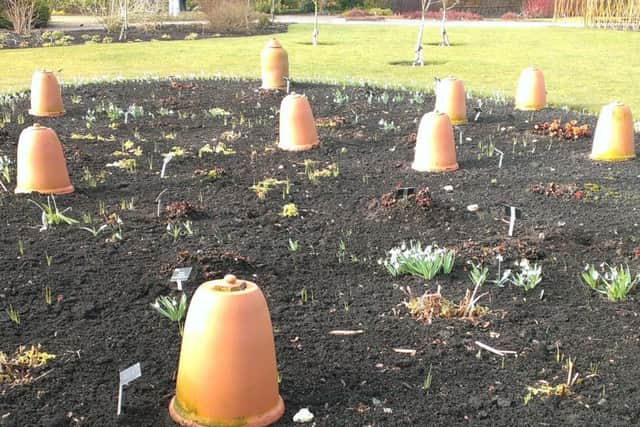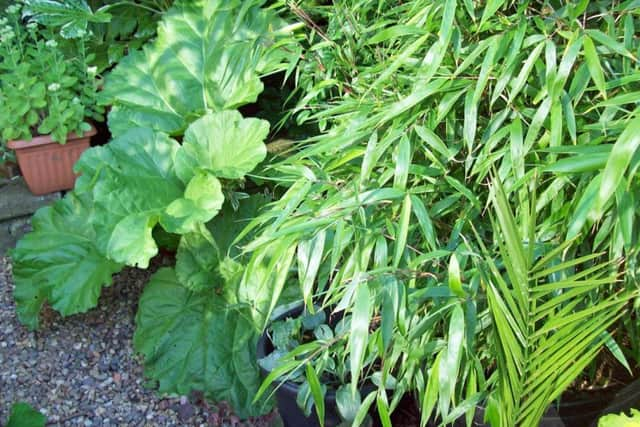Gardening: Time to '˜force' that trendy rhubarb for this year's crop


Using an established plant, cover the crown with straw and place a large bucket over the top to exclude light.
You can use a traditional terracotta forcer, like these ones pictured at RHS Harlow Carr – but they’re really expensive and a cheap bucket works just as well.


Advertisement
Hide AdAdvertisement
Hide AdThe pale pink, tender stems can be harvested about eight weeks after covering.
Don’t force the same crown for two years in a row, as it weakens the plant.
If you can wait for a natural crop, all the better, as patience is needed for a rhubarb plant to build itself up.
Pot-grown rhubarb can be planted at any time, in an open, sunny site with free-draining soil. With crowns, plant late autumn-early winter. You can plant later, but run the risk of crown rot.


Advertisement
Hide AdAdvertisement
Hide AdIf you planted new crowns in autumn, don’t harvest during the first year. Remove a few stems the next year, then up to a third or half from then on. It’s best to stop cropping by June (unless you have an autumn-cropping cultivar), or at least only remove a few stalks after then – older varieties often go stringy then and the plant needs the sustenance.
HOW TO GROW GUIDE
l Planting time (pot grown): Anytime.
l Crowns: October-December.


l Harvesting time: early spring (forced) to midsummer; autumn for late varieties.
l Planting distance:Space plants 75-90cm (30-36in) apart, with 30cm (12in) between rows.
l Aspect and soilL: Sunny, well-drained soil (will tolerate some shade).
l Hardiness: Hardy.


l Difficulty: Easy.
Advertisement
Hide AdAdvertisement
Hide Adl Recommended varities: Timperley Early: Thick stems, early, high yield. Bred for forcing; performs very well outside, but even better colour when forced. Victoria: Late (summer) type with heavy yields.Hawke’s Champagne: Compact plants with high yield potential. It has bright red, medium length, uniform stems.Livingstone: Autumn cropping, from September to November.
GET IN TOUCH
l For more information, plus cook what you grow, recipes, environmental news and more, log on to www.mandycanudigit.com (now smartphone friendly), follow me on Twitter @MandyCanUDigIt or you can like me on my Facebook page at Mandycanudigit
JOBS TO DO THIS WEEKEND
Lily bulbs can be planted in pots, for flowers this summer. After growing on in a cool greenhouse, they can be moved on to the patio when in flower.
Check tender plants overwintering outdoors to make sure protective coverings are still in place.
Advertisement
Hide AdAdvertisement
Hide AdContinue to deadhead winter pansies and other winter bedding. Pansies will carry on into the spring and even to early summer if attended to often.
Cut off old leaves of hellebores that produce flowers from ground level (including Helleborus x hybridus and H. niger) to expose the flowers and remove possible foliar diseases such as hellebore leaf spot.
Look out for rot (such as crown rot, Sclerotinia, delphinium black blotch, black root rot and Antirrhinum rust) on emerging perennials.
Many summer-flowering deciduous shrubs can be pruned now – those that flower on the current year’s growth, including Buddleja davidii, Ceratostigma, Hydrangea paniculata, Lavatera, Leycesteria, Perovskia, hardy fuchsias, and deciduous Ceanothus.
Advertisement
Hide AdAdvertisement
Hide AdPrune Wisteria by cutting back the side shoots shortened by summer pruning to two or three buds (2.5-5cm/1-2in). Avoid cutting off flower buds.
Dig a new pond.Have a minimum depth of 60cm (2ft) at the deepest point, to reduce the risk of the pond freezing totally. Gently sloping contours between the shallow and deep areas, and between the bank and the water, are more wildlife-friendly.
If you do have any seedlings, make sure they are getting the maximum light available, or else they will become weak and leggy. If necessary, turn them once a day so that they get light on both sides. This will stop them leaning over towards the light, and keep them upright and compact.
Plug plants can be grown on in your greenhouse, being a relatively cheap source of large numbers of plants.